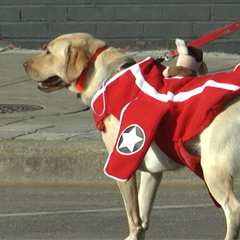October 31, 2016
K-State veterinarian shares 10 tips to keep pets safe on Halloween

Scary costumes and candy galore, Halloween can be fun for children and adults alike, but for our pets it can be a terrifying and even a potentially dangerous holiday.
"Keeping these 10 tips in mind can help make the holiday safer and less stressful for our furry family members," said Susan Nelson, clinical associate professor in clinical sciences at the university's Veterinary Health Center.
• Try on pet Halloween costumes as much in advance as possible to give animals time to acclimate to them.
• Ensure that pets can see, hear, smell and breathe when in costume.
• If you choose to dress up your pet, avoid costumes that have any loose or small parts that can be pulled off and ingested.
• If your pet seems distressed, allergic or shows abnormal behavior with a costume, consider having it wear a Halloween-themed bandana.
• Strange visitors in scary costumes and loud noises may cause even the most social and/or calm animal to be frightened and react negatively. If concerned, keep your pet in a back room with the radio or TV turned on to help drown out noise caused by ringing doorbells and excited children, or to prevent them from running out the door.
• Make sure your pet has proper forms of identification, such as a microchip or tags. A reflective collar also may help others to spot your pet, should it go missing at night.
• Don't keep candy out in easily accessible places. Chocolates, sugar-free candies, raisins and some nuts can be toxic to pets. Candy wrappers and lollipop sticks also can become choking hazards or gastrointestinal foreign bodies if ingested.
• Cats, especially black ones, are often sought after with cruel intentions during Halloween, and caution needs to be exercised during the time to keep them safe.
• Keep pets away from electrical cords and decorations. Chewing on electrical cords can lead to life-threatening electrocution and burns. Decorations, especially corncobs, can be ingested and cause obstructions in the gastrointestinal tract.
• Keep lit pumpkins and candles out of reach, as they can burn your pet. A frightened or curious pet also can tip over a candle, which could lead to a house fire.
For more information, contact the Kansas State University Veterinary Health Center at 785-532-5690.
